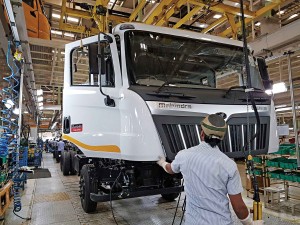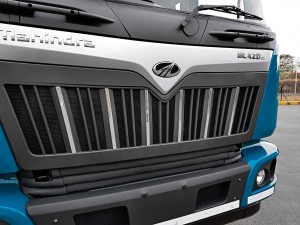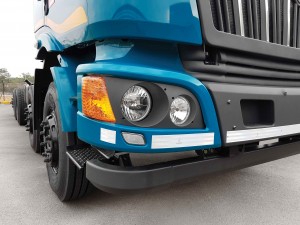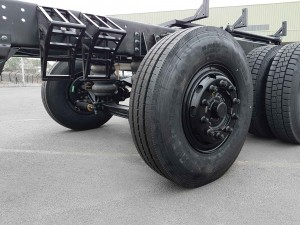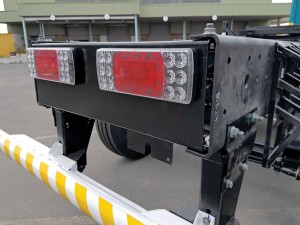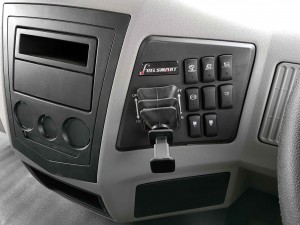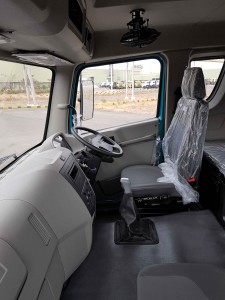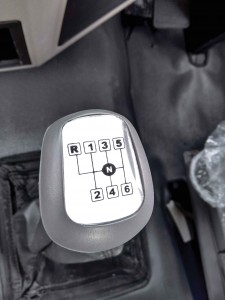With the Blazo range, Mahindra Trucks and Buses Limited, is aiming at addressing varying requirements of transporters in a bid to double the market share in the next two and a half years. Story and photographs:
Bhushan Mhapralkar
Mahindra unveiled the Blazo truck at Auto Expo 2016. The move signalled a significant change at Mahindra Trucks and Buses Limited, a business vertical of USD 17.8 billion Mahindra Group. Offering multi-mode technology, the Blazo pointed at digitisation. It also hinted at a change in the company’s strategy to structure its product range. Unlike the Torro, Traco and Truxo, the Blazo is actually a range of medium and heavy trucks. They do not succeed the Torro, Traco, or the Truxo, and instead build upon the company’s experience of building trucks since 2005. Reflecting upon the future, the Blazo range comprises of a 25-tonne cargo carrier and tipper, a 31-tonne cargo carrier and 8×4 tipper, a 35-tonne car carrier and tanker, a 37-tonne cargo carrier and cowl chassis, a 40-tonne tractor-trailer and tip-trailer, and a 49-tonne 6×4 tractor-trailer.
Smart looks, smart tech
In terms of appearance, the Blazo does not mark a drastic change. It shares the line at the Chakan plant with the Torro, Traco and Truxo. It also shares a good deal of components with them. Subtle visible changes are what sets the Blazo apart. The most prominent are the body coloured head lamp surrounds. The grille gets an amount of chrome. The doors flaunt ‘Fuelsmart’ stickers, which hint at the technology at the heart of the truck. Announces Nalin Mehta, Managing Director & CEO, Mahindra Trucks and Buses Limited, “We have worked on the look of the truck. We have worked on the air flow.” He does not mention about the ‘Fuelsmart’ technology as yet. It is for the latter. Open the door, and the modern interior of the four-post suspended cabin presents itself. There’s good deal of plastics. This however is not were an excercise to light weight the truck lies. It is in the use of stronger and lighter grade steel for the manufacture of some of the crucial components according to Mahindra sources. The dashboard may look familiar but carries significant changes.
Consider the Blazo 37 for example. Those familiar with the interior of the Truxo 37 will find the Blazo familiar. The dashboard may look similar, There is a significant difference. The instrument panel is new and car-like. A wide array of warning lamps give the impression of a christmas tree lighting up as they appear. They disappear as the engine wakes up. The analogue brake air pressure gauges have gone digital. They are now part of the LCD readout (DIS) at the centre of the instrument panel. States Mehta, “The Blazo not only looks different, but also behaves differently.” “We took much effort to build the Digital Information System (DIS). The fuel efficiency indication on the DIS is plus or minus two per cent,” he adds. To the left of the instrument console are an array of switches in what looks like a switch bank. The parking brake lever is also at this location. What looked a bit bland on the Truxo 37 looks smart on the Blazo 37. The three multi-mode switches in the switch bank draw attention. They are the highlight of this truck. The three ‘mode’ switches are also an indication of the efforts that have gone into the development of the Blazo. Explains Mehta, “The Blazo stands for multi-mode.” “We decided to address different preferences in one product line. We created drive cycles, which were appropriate to various applications. The challenge was to switch from one operating cycle to another without causing trouble. The need was to be able to change cycles on the fly. The driver should be able to engage ‘Turbo’ mode when he encounters a gradient. He should be able to engage the ‘Light’ mode when he is running empty,” he explains. The ‘Fuelsmart’ technology, it is clear at once, is about fuel efficiency and performance.
Addressing differing needs
Work on the Blazo started 15 to 17 months before it was unveiled at Auto Expo 2016. Engineers fitted the electronically governed 7.2- litre engine with multi-mode on trucks of some customers. This would provide an opportunity to optimise the engine. “It took us one and a half year to optimise the engine. We tested the engine by installing it on some of our customer trucks. The outside world did not know that this was a multi-mode truck. Once we were confident we decided to launch the product,” reveals Mehta. Forming the basis of the Blazo range, the electronically governed, BSIV ready 7.2-litre common-rail turbo diesel engine traces its origin to an electronically governed engine the company was offering on a 40-tonne tractor (prime mover) earlier. The company, mentions Mehta, saw a clear indication that different applications required different fuelling cycles. “The move to BSIV would entail the application of common-rail technology. Customer demand was to have flexibility,” he states.
To address the differing needs of customers, the company studied in detail their operating patterns. It was found out that they would travel without load. Even some very good transporters would run 20 per cent of the operation without load. “Applications like tankers often return empty. There are different road conditions and load conditions. Car carriers are about volumes. There are those that load more; the ODC requirement for example. The challenge was to address different needs in one product line. The creation of drive cycles, which were appropriate to various applications, would be the best way to do it,” expresses Mehta. The electronically governed 7.2-litre common-rail turbo-diesel engine produces between 220 hp and 274 hp on the Blazo (range). The peak torque it produces is 800 Nm and 960 Nm respectively. The transmission offered are six-speed and nine-speed units. The 40-tonne and 49-tonne tractor for example, are equipped with an Eaton nine-speed (with crawler gear) and ZF nine-speed (with crawler gear) gearbox respectively.
Better payload capacity
Apart from light weighting to improve payload capacity, the rear axle ratio of Blazo was optimised according to Mehta. “We specifically looked at two or three applications. We created a model for concrete mixer and a tipper. We reduced the wheelbase of our tractor to help our customers meet the new regulations for car carriers,” he adds. Since January 2016, over 1500 Blazos have been sold, claimed a Mahindra source. Helping the company to carve out a greater pie of the market, which is currently 3.5 per cent, the Blazo saw the involvement of Bosch. Bosch did an excellent job of developing different drive modes according to Mehta, based on the road-load data Mahindra had collected. “Bosch helped us to arrive at the three drive cycles as per our needs,” Mehta states. He adds, “Mahindra engineers drove the truck for over two-lakh kilometers to achieve the right calibration.” Customer co-operation meant a few thousand trucks were running with the technology even before the Blazo was formally launched.
Behind the wheel
The three-way adjustable, suspended driver seat offers a commanding driving position. I am at the helm of the Blazo 37. The view ahead through the large windshield is uninterrupted. As the engine comes to life, the first impression is that of refinement. Over the Truxo 37 that I briefly drove last year, the Blazo 37 feels refined. The electronically governed engine is clearly less noisy and restless. “The electronic engine has translated into less vibrations,” says Mehta. “We carried out ‘running’ improvements in the wiring harness, the propeller shaft, the chassis, the suspension, etc.,” he adds. Get going, and the Blazo feels quite responsive. It feels eager. The ‘turbo’ mode is on. Producing a flat peak of 800 Nm between 1100 and 1700 rpm, the Blazo 37 feels tractable. The move to ‘heavy’ mode brings about a change in the behaviour. The truck feels a shade less eager, and as tractable. Comfortable and refined to drive, in the ‘light’ mode, the Blazo feels a little less responsive. The engine feels like it is running lean. The fact is, it is burning less fuel, and conserving power by about 40 per cent of the 100 per cent power available in the ‘turbo’ mode. The ‘light’ mode is engineered for use when running empty. It provides the operator an opportunity to save fuel. A 10×4 rigid truck with a rear tag axle, the Blazo 37 is the most popular among the trucks Mahindra sells in the M&HCV category. Of the trucks that Mahindra Trucks and Buses sells, the Blazo, in a span of an year, has come to account for 30 per cent of the CV sales according to Mehta. The good part is, the Blazo makes clever use of electronics to address the different needs of different operators. This way, it is helping the operators to earn more. Comfortable, modern, and easy to maneouvre, the Blazo 37 that I drove, reflected upon the work that has gone into developing it; into the development of the Blazo range. The Blazo makes a promising proposition for a transporter for certain, and in an environment that is becoming complex and challenging.
Blazo as a package
As a package the Blazo brings with it a driver trainer. The aim, states Mehta, is to create drivers out of those who have been driving by improving their skill sets. “Driver training about Blazo is to use the multi-mode. We are ensuring that customer drivers are trained. We sit with the driver and show him which mode to use when,” mentions Mehta. The electronic nature of Blazo makes it future ready. It is truck that can address the complex needs of the market. The Torro, Traco and Truxo will fall behind when the BSIV emission norms are implemented in April. The BSIV emission compliant Blazo will become the mainstay. Costing about a lakh and a half rupees more than an equivalant Torro, Traco or Truxo truck according to Mehta, the Blazo has a lot going for it. By shelling out 10 per cent more the transporter gets a truck that is modern, efficient and drivable. The digital nature of the Blazo gives it the ability to offer a lower TCO.





